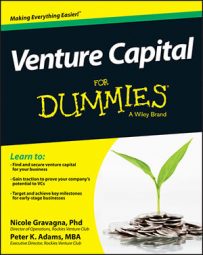First time entrepreneurs looking for capital are often diligent and work out a detailed plan of expenses and burn rate needed to launch their company. They then set out to raise that amount of money. This approach is flawed!
Your venture company increases in value with every milestone that you hit. If you raise 100 percent of what you need at the beginning, you’ll be lucky to end up owning 1 percent of the equity by the time your liquidity event comes along.
To raise the money you need while maximizing your own equity stake, you need to develop a phased capital raising strategy. Most companies have four or more phases, starting with friends and family, then angel funding, then a Series A, followed by Series B. Some companies even get up to Series D or E offerings.
If you raise too much money, then you have given up too much equity at a cheap, early-stage price. Just a little bit too much is okay, since that’s like an insurance policy that you have enough runway to make it to your next round.
If you raise too little money, then you won’t be able to achieve your milestones, which means that you may never raise another round and you may end up closing down your company.
Decide how much to pay yourself
You’re CEO – right? So your salary should be $1 million? Not if you want to raise venture capital! The rule of thumb is that even if you’re a CEO, your salary should be the minimum amount needed to get by. Just rent and groceries — no fabulous trips to Tahiti on your yacht, at least not yet!
The venture capitalist (VC) wants to have your rewards aligned with theirs. That means that both of you need to be focused on the exit. Big salaries are for people who work in big companies and don’t have the windfall of a big exit hanging in the future like a carrot in front of a horse.
At an early-stage company, everyone should be working for some combination of equity and salary, and the salary should be as little as possible.
Avoid a bridge to nowhere
Here, use the concept of a bridge to help you think about investment rounds. The company is here now, and with financing, it will be able to get to there via the bridge of capital. The bridge to nowhere refers to a poorly defined financing round. The company is here now and wants to raise $500,000 to get through its next milestones.
If completing those milestones doesn’t happen on schedule or if completing the milestones does not represent a significant reduction in risk, then there may not be a pool of available investors for the next round. You need to be creating a strategy for each funding round that will make your company increasingly attractive for future rounds.
Financing a company with a bridge to nowhere leaves the company with more investors or debt, and no more milestones achieved. This situation is often caused by over-optimism on the part of the entrepreneur who failed to plan for the possibility that their original plans would take longer to execute than they thought.
These cases can be prevented by consulting with fundraising experts and listening to their advice so that you understand what investors are looking for at each phase of investment and what the norms are for milestones to be accomplished in each round.
One advantage of working with VCs and building a strong relationship is that the VC who invested in your Series A round will likely be the VC who invests in your Series B round. In many cases, the VC will invest simply to have the option to continue investing if your team is able to execute.
Most venture capital funds keep 50 percent of their fund in reserve to fund Series B investments. If you work with one of these companies and you are able to perform on your plan, then you are most likely to raise your Series B round and avoid a bridge to nowhere.

